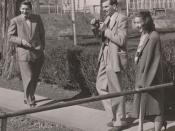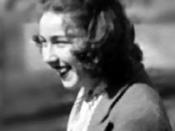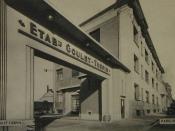- Well written-Good points
A Critical Analysis of "Revelation"
by Flannery O'Connor
Flannery O'Connor's background influenced her to write the short
story "Revelation." One important influence on the story is her Southern
upbringing. During her lifetime, Southerners were very prejudiced towards
people of other races and lifestyles. They believed that people who were less
fortunate were inferior to them; therefore, people were labeled as different
things and placed into different social classes. The South provided O'Connor
with the images she needed for her characters. Similarly, this can easily be
identified in her short story "Revelation." The characters in the story are
identified by physical characteristics and some are even identified with racial
terms. The main character in the story is actually prejudiced and makes many
statements using racial jargon. For example, Mrs. Turpin, the main character,
refers to the higher class woman as "well-dressed and pleasant".
She also
labels the teenage girl as "ugly" and the poor woman as "white-trashy".
When Mrs. Turpin converse with her black workers, she often uses the word
"nigger" in her thoughts. These characteristics she gives her characters
definitely reveals the Southern lifestyle which the author, Flannery O'Connor,
was a part of. In addition to her Southern upbringing, another influence on
the story is Flannery O'Connor's illness. She battled with the lupus disease
which has caused her to use a degree of violence and anger to make her
stories somewhat unhappy. The illness caused a sadness inside of Flannery
O'Connor, and that inner sadness flowed from her body to her paper through
her pen. Although she was sick, O'Connor still felt proud to be who she was.
By comparison, Mrs. Turpin in "Revelation" has a good disposition about
herself. She is far from perfect, yet she is happy to be who she is. Perhaps
the most important influence on the story is religion. In the words of Robert
McCown, O'Connor's writing was mainly generated by a most powerful
Christianity which was fed by her Catholic background (McCown, 256).
O'Connor was not only influenced by her own Catholic heritage but by others
as well. Like the other writers from France and England, she is curious about
the actuality of sin and the effect that it has on the presence of mankind. Her
stories and every characteristic about them was Flannery O'Connor's way of
showing reality and qualities that are determiners of fate and destiny. No
matter which path her stories took her readers, they mostly ended up finding
social truth. This background, together with a believable plot, convincing
characterization, and important literary devices enables Flannery O'Connor in
"Revelation" to develop the theme that sometimes people must look farther
than the surface in order to understand the actions of others.
To develop this theme, O'Connor creates a believable plot by using a
social conflict, the element of surprise, and an unhappy ending. The main
social conflict that appears in this story is not determined until a good portion
of the story has passed. There are, however, incidents that build up to the
actual conflict. The story "Revelation" has a major and a minor social
conflict. The minor conflict is between Mrs. Turpin and a white-trash
woman. This conflict is born because Mrs. Turpin believes she is in a higher
class than the white-trash woman. The white-trash woman is unintelligent
and uneducated, and Mrs. Turpin is repulsed when she speaks and interrupts
her conversation with someone else. The major social conflict is between
Mrs. Turpin and a teenage girl across from her. This conflict is built up over
the course of the story through rude gestures and facial expressions given by
the teenage girl. For instance, Mrs. Turpin makes a comment about a clock.
The girl looks at the clock and smirks which was followed by another smirk
toward Mrs. Turpin. Mrs. Turpin also acknowledges a look the girl gives her
as the "ugliest face she has ever seen anyone make" (O'Connor, 394). It was
like the girl has known and disliked Mrs. Turpin all her life. Another element
of plot which reinforces the theme of "Revelation", is the element of surprise
which actually brings the main conflict out in the open. O'Connor brings the
conflict out well because the incidents that built up to the actual conflict do
not give away what is going to happen. The action around the conflict is
completely surprising and unpredictable. We are aware the girl dislikes Mrs.
Turpin because of her previous actions. The girl never does anything other
than give dirty looks; therefore, we are not expecting any type of physical
violence between them. When the girl hits Mrs. Turpin in the face with the
book, Mrs. Turpin is conversing with another character and is not talking to
the girl. In this situation, a violent act by the girl is completely unpredictable.
Also, O'Connor uses an unhappy ending for this story. Mrs. Turpin, who is
happy being who she is, does not understand why the girl hated her. She
does not think she is a bad person, and she cannot comprehend why she is
not liked. O'Connor ends the story with Mrs. Turpin's questions unanswered
which leaves her with a sadness that is unsolvable. Through the use of social
conflict, the element of surprise, and an unhappy ending, a believable plot is
created.
To further develop the theme, O'Connor uses consistent behavior, clear
motivation, and plausibility to create convincing characterization. The
protagonist, Mrs. Turpin, is convincing because she consistently curious and
involved in conversation. She is also consistently observant of the other
characters. Over the course of the story, Mrs. Turpin does not change;
therefore, she is a static character. O'Connor's characters are victimized and
are images of lower intelligence. Mrs. Turpin, however, does appear to be of
average intelligence. Her behavior in the story mirrors the Southern image
given to her by O'Connor. In the beginning of "Revelation," Mrs. Turpin is
a polite and outgoing individual, and these are characteristics that remain with
her. In addition to consistent behavior, Mrs. Turpin is convincing because
she is mainly motivated by her insecurity. Her motivation for appearing at the
doctor's office is clearly because her husband is injured. She also feels a
need to observe the other patients so she can draw conclusions as to why they
are there. Mrs. Turpin is a friendly and curious woman which explains her
continuous conversations with anyone who will listen. Even though she
notices the hatred given off by the teenage girl, she continues to act ignorant
of it. A possible motivation for her continued talking could be that she is
deterring from a confrontation. Another characteristic of Mrs. Turpin is her
plausibility. In this story, she is very plausible because her personality and
characteristics model those of a lifelike person. She is curious and observant
just like everyone else and she also enjoys a friendly conversation. O'Connor
makes Mrs. Turpin an average Southern citizen with an average Southern
attitude. With these characteristics given to her, Mrs. Turpin has become a
plausible protagonist in the story "Revelation." Through consistent behavior,
clear motivation, and plausibility, convincing characterization of the
protagonist is developed by O'Connor.
O'Connor's use of important literary devices such as symbolism and
foreshadowing allow her to reinforce the theme. Many think of O'Connor's
writing as humorous. In most of her stories, she uses a technique that is, for
the most part, comic. Humor is one way O'Connor masks what she is
actually trying to say. She was considered a tragic ironist which wasn't
understood by some people. O'Connor's stories also include much
symbolism like in her story "Revelation." In this story, there are several
points of symbolism. The teenage girl extremely dislikes Mrs. Turpin from
the beginning of the story to the end of the story. Her dislike grows
throughout the story and then erupts like a volcano. When her anger erupts,
she throws a book at Mrs. Turpin. This book symbolizes her hatred toward
Mrs. Turpin. It symbolizes her hatred because in a book, the plot develops
and builds up over the course of the book. This is exactly what her anger did
toward Mrs. Turpin. The book is not the only symbolism in "Revelation." In
the doctor's office, there are several types of people. These different types of
people symbolize the different types of social classes. For example, the
white-trashy woman represents the lowest class with uneducated intelligence,
the well-dressed woman represents a class of higher standards and
intelligence along with an educated background, and Mrs. Turpin represents a
middle, working class with average intelligence and educated background.
Another literary device O'Connor uses is foreshadowing. The facial
expressions and actions of the girl show a conflict between her and Mrs.
Turpin. Specifically, the smirks given toward Mrs. Turpin and the grunts
made when Mrs. Turpin speaks were the rude gestures from the teenage girl.
The increase of these rude gestures foreshadows a confrontation between the
two, but the actual time of the confrontation is unclear. In conclusion,
symbolism and foreshadowing are two important literary devices used by
O'Connor in "Revelation."
After analyzing how the author's background, the plot, and the literary
devices contribute to the development of the theme of "Revelation", one
understands why this story rates high on the literary scale of value.
"Revelation" was a doorway for Flannery O'Connor. She used this doorway
to reveal her beliefs and disbeliefs about mankind and the mysteries that it
beholds. O'Connor was influenced many ways throughout her lifetime and it
was her writing that helped her deal with the problems she faced and the
things she believed in. "Revelation" was just one of her many stories that
served as a translator of her past. It was through this story that O'Connor
revealed her outlook on prejudice and the effects that some people had on the
human race. O'Connor achieved her purpose because she successfully
portrayed her characters in the manner most suitable to convince her readers.
O'Connor needed to express her concern and curiosity toward life and death,
mainly death. She might have also been looking for a way to cope with death
by writing her stories. "Revelation" was her way of suppressing her anger
toward people of lower standards. She suppressed her anger by writing what
she thought about them; therefore, releasing herself from the anger she felt.
She was a Southern writer, and from this writing habit she rec





